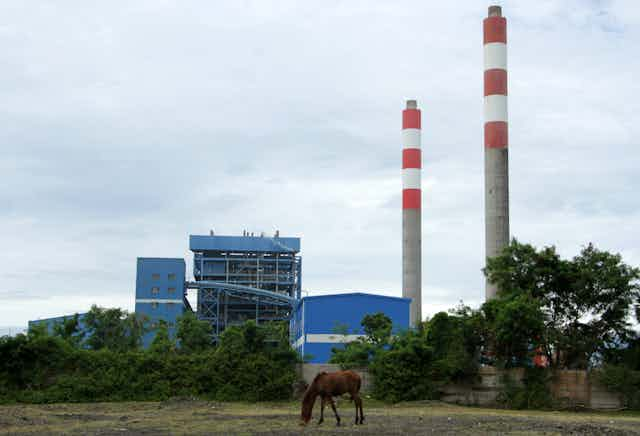Indonesia, one of the biggest emitters in the world, is planning to launch its pilot emissions trading scheme in July, which can possibly become the first national carbon market in Southeast Asia.
Emissions trading schemes allow firms to trade emission rights. Firms with low abatement costs will be given incentives to reduce emissions and sell their emission permits to firms with high abatement costs, enabling an economy to achieve emission reductions in the least cost manner.
Here is what we know so far about Indonesia’s pilot emissions trading scheme:
It is likely to start with a narrow scope and gradually expand to cover more entities.
The Indonesian pilot scheme will cover only coal-fired power plants.
These coal-fired power plants are divided into three categories:
(1) Power plants with capacity over 400 megawatt-hour (MWh), (2) Power plants with capacity between 100 and 400 MWh (3) Power plants with capacity over 100 MWh.
The initial small coverage will keep things manageable for the regulator. However, it also implies the effectiveness of the scheme in delivering emission reductions will be limited.
An intensity-based cap, rather than an absolute cap, is likely to be imposed on regulated entities.
There are two main types of emissions trading schemes - cap-and-trade and baseline-and-credit. Under a cap-and-trade, a limit or a cap is placed on the total emissions of an economy. Under a baseline-and-credit, a baseline or benchmark is created for each type of emitting activity.
Indonesia’s scheme will not be a classic cap-and-trade system as it will not limit the total emissions of coal-fired power plants. In some ways it will operate more like a baseline-and-credit system that sets different benchmarks for different categories of coal-fired power plants.
At this stage,the Indonesian government is aiming to help coal-fired power plants reduce their greenhouse gas emissions per unit of output. The benchmarks proposed are intensity-based caps that follow unit production, rather than an absolute cap on emissions.
Thus, coal-fired power plants can still burn more coal to produce higher electricity output if they follow the benchmarks and do it more efficiently than before. This may undermine the ability of the power sector to reduce emissions by 314-398 million tonnes in 2030, as currently targeted. The reduction required is almost same as taking 75 million cars off the road for an entire year.
Free allocation will probably take place in the initial phase.
Under the pilot scheme, the Indonesian government will give permits to coal-fired power plants to cover some of their emissions at no cost.
The number of permits granted will be determined based on a simple formula: the intensity cap - with different cap for each category of power plants - multiplied by the output planned.
This arrangement will give a power plant more permits if it intends to produce more electricity.
Entities may have two or more options to pay for those green house gas emissions not included in any free allocation.
The Indonesian government has introduced a hybrid form of carbon pricing. The regulated entities can account for their excess emissions by purchasing permits from a carbon market. They may also use offset credits to balance out their carbon footprints by investing in renewable energy projects elsewhere.
Non-regulated entities, on the other hand, will be subject to a carbon tax levied by the Indonesian government, presently charged at US$2.10 per tonne of carbon equivalent. The government has stipulated the tax to be no lower than the permit price.
The government will set up an integrated monitoring system
The monitoring system will be linked to a national registry system to monitor and capture emissions data submitted by regulated entities through their annual reports. The recorded information will be the basis for calculating the number of available permits for initial allocation.
Non-compliant entities may face administrative sanctions
Regulated entities that fail to register or report their emission activities may face administrative sanctions in form of government warnings, coercion, fines and suspension or revocation of emission permits.
The sanctions are regulated under a presidential decree. Given the pilot phase is meant to be a ‘learning-by-doing’ period, no sanctions have been announced by the Indonesian government.
Read more: Three steps Indonesia can take to create a solid domestic carbon market
Unknown details
At this point, many elements regarding the scheme remain unknown.
Further details are expected to be made publicly available on areas such as the trajectory of the emission intensity cap, the use of banking and borrowing mechanisms, and the establishment of a reserve account to control fluctuation in permit prices.
Given the complexity of carbon market elements, some technical guidelines should be provided. The World Bank’s FASTER Principles for Successful Carbon Pricing offers a comprehensive guide for designing effective carbon-pricing instruments (carbon taxes hybrid tools).
Affected stakeholders need to know the roll-out plan of the scheme to prepare for a new carbon price, which will potentially lead to higher electricity costs. Thus far, the Indonesian Government is heading in the right direction.
Nevertheless, it should do more to garner public support for carbon pricing when the Indonesian people are promised stable power prices to cope with rising living costs.

